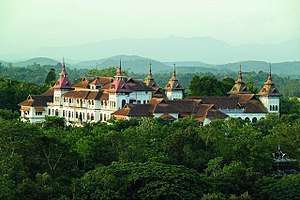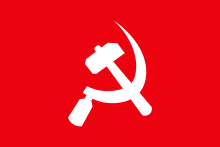Punnapra-Vayalar uprising
The Punnapra-Vayalar uprising (October 1946) was a communist uprising in the Princely State of Travancore, British India against the Prime Minister, C. P. Ramaswami Iyer and the state.[1] Communist Party members were killed by the army of the Diwan (Prime Minister), 470 people at Punnapra on 27 October and more than 150 at Vayalar on 28 October. The total loss of life is allegedly estimated to be more than a thousand.[1]
| Part of a series on the |
| History of Kerala |
|---|
 |
|
Main Megalithic culture Maritime contacts |
|
Other topics |
|
| Punnapra-Vayalar Uprising | |||||||
|---|---|---|---|---|---|---|---|
| Part of Communist Movements in Travancore against the Diwan | |||||||
 Memorial of Punnapra-Vayalar uprising martyrs located near Kalarcode, Alappuzha | |||||||
| |||||||
| Belligerents | |||||||
|
|
Laborers in Punnapra and Vayalar | ||||||
| Commanders and leaders | |||||||
| K. Kelappan | P. Krishna Pillai, T. V. Thomas, M. N. Govindan Nair, R. Sugathan, S. Kumaran, V. S. Achuthanandan | ||||||
| Casualties and losses | |||||||
| 40 deaths | More than 1,000 people dead | ||||||
Historians like Prof Sreedhara Menon[2] (though one website claimed that he had retracted his views later[3]) maintain this was a proper struggle against the declaration of 'Independent Travancore' by the then Travancore .Communist leaders trained the people initially by telling them that rubber bullets will be used by police, this was a plan to hatch the uprising by fooling masses . T K Varghese Vaidyan, a leader of the struggle, had gone on record saying it was a rehearsal for a larger revolution with the ultimate objective of establishing a "Communist India".
Background
Sir CP Ramaswami Iyer had proposed constitutional reforms making Travancore an independent country, not joining Indian Union. CP had proposed an 'American model' for Travancore. The Communists in Travancore opposed this move with the slogans, 'Chuck the Americans and British agents into the Arabian Sea'. The struggle against the Travancore Kingdom began in 1939 when the merger of socialist parties, which created a new radical communist party. The brutal famine conditions in Travancore Kingdom during the Second World War had pushed the peasants towards the Communists. Over 21,000 peasants died in Cherthala taluk alone during the Famine (1939–43). Discontent in Cherthala and Ambalapuzha taluks grew against Diwan. In March 1946, Alappuzha was filled up by Travancore Police to crack down the members of ATTUC (All Travancore Trade Union Congress).
In response, over 2,000 communists attacked police stations all across Alappuzha and practically established their own communist government. The communist government was established from Cherthala to Ambalapuzha, a stretch of 40 kilometres (25 mi) in Alappuzha. The communist cadres in Alappuzha were given military training by ex-servicemen who had returned home from the Second World War. The communist cadres were armed with country weapons, especially varikundams (spears made out of arecanut tree stems).
On 25 October 1946 (Maharajah's Birthday), the new Travancore constitution was to be implemented, making Travancore an independent country. Over 1000 communists in Vayalar fiercely retaliated this move and this led to attacks and deaths of Travancore police officials and government officials in that region. Dismayed by the turn of events, the Diwan declared martial law in Alleppey on 25 October 1946. The Travancore army moved from their camp and surrounded the communists at Vayalar by 27 October. The Travancore navy supported the army in isolating Vayalar, which is surrounded by water on three sides. Once the blockade was in place, the army moved in. A prodigious killing then took place, and over 470 communists were massacred within few minutes. When the communist front line reached the Travancore army, a brutal hand-to-hand combat took place and 40 Travancore soldiers were killed.
On the same day, at least 130 people were killed in army firings, elsewhere in the district. The local people and press maintain that many more people were killed and the bodies disposed by the army. Historian A. Sreedhara Menon estimates that over a thousand people were killed during the Punnapra-Vayalar outbreak. Atrocities were not one sided, and there are reports of murders of Travancore policemen after they had surrendered to the communists, during the early stages of the disturbances. Police Inspector Velayudhan Nadar had moved forward to reason out with the communists, but he was brutally stabbed to death. This hardened the stance of the police and the armed forces. Following the suppression of the communist local governments, the Travancore police used heavy-handed methods to repress the political movement in the region and detained many activists without any trial.
In order to achieve this aggressive police response, the Diwan C. P. Ramaswami Iyer had to sideline his General Officer Commander (G.O.C.), V.N. Parameswaran Pillai, in favor of the Inspector General, Parthasarathy Iyengar, who shared the Diwan's views.[4] The G.O.C. subsequently resigned.[4]
After effects
The killings of communist comrades turned the Communists and even many non-communists totally against Iyer. When, on 3 June 1947, United Kingdom accepted demands for a partition and announced its intention to quit India within a short period, the Maharaja of Travancore desired to declare himself independent.[5][6][7] Supported by the Diwan, C. P., Chithira Thirunal issued a declaration of independence on 18 June 1947.[5][6][7]
As Travancore's declaration of independence was unacceptable to India, negotiations were started with the Diwan by the Government of India. Even Sardar Patel in presence of Mountbatten had warned Sir CP and Travancore Kingdom against the move for Independence.[8]
Family sources indicate that C. P., himself, was not in favour of independence but only greater autonomy and that a favourable agreement had been reached between C. P. and the Indian representatives by 23 July 1947 and accession to the Indian Union could not be carried out only because it was pending approval by the Maharajah. Nevertheless, an assassination attempt was made on C. P. by K.C.S. Mani who was an activist of the Socialist group led by N. Sreekantan Nair on 25 July 1947 during a concert commemorating the anniversary of Swathi Thirunal.[6][9][10]
| Part of a series on |
| Communism in India |
|---|
 |
|
Personalities
|
|
Cold War years
|
|
Other articles |
|
|
Views
Historian Manu S Pillai described Punnapra-Vayalar as an Ezhava-Dalit uprising against the Travancore Kingdom. The communists who took part in Punnapra revolt were mostly coir workers of Rural Alappuzha. They still form the backbone of Communist parties in Kerala even today. Punnapra-Vayalar is described by Robin Jeffrey as the only moment in history when an organised working class led an armed revolt against a British-backed kingdom.[11]
References
Citations
- Manorama Yearbook 2011, ISSN 0970-9096
- page 373, 374, A Survey of Kerala History by Prof. Sreedhara Menon, S. Viswanathan Printers and Publishers, Madras, 1996,
- D, Jose (1997). "Punnapra Vayalar uprising can't be part of freedom struggle". Rediff On The Net. Retrieved 4 April 2014.
- K. Ramachandran Nair (2006). The history of trade union movement in Kerala. p. 89. ISBN 8178271389.
- Dominique Lapierre, p. 260
- Dominique Lapierre, p. 261
- A. G. Noorani (2003). "C.P. and independent Travancore". Frontline. 20 (13).
- Sir C. P. Remembered, p. 111
- Sir C. P. Remembered, p. 113
- K. N. Panikker (20 April 2003). "In the Name of Biography". The Hindu. Archived from the original on 3 January 2013. Retrieved 13 May 2020.
- https://www2.warwick.ac.uk/fac/arts/history/students/modules/hi297/lectureandseminartimetable/seminar5/robin_jeffrey_-_indias_working-class_revolt_-_punnapra-valayar.pdf
Bibliography
- "Punnapra Vayalar revolt".
- Sreedhara Menon. Sir C.P. Thiruvithamcore Charithrathil (in Malayalam).
- Prof. A. Sreedhara Menon. A survey of Kerala History.
External links
| Wikimedia Commons has media related to Punnapra-Vayalar uprising. |